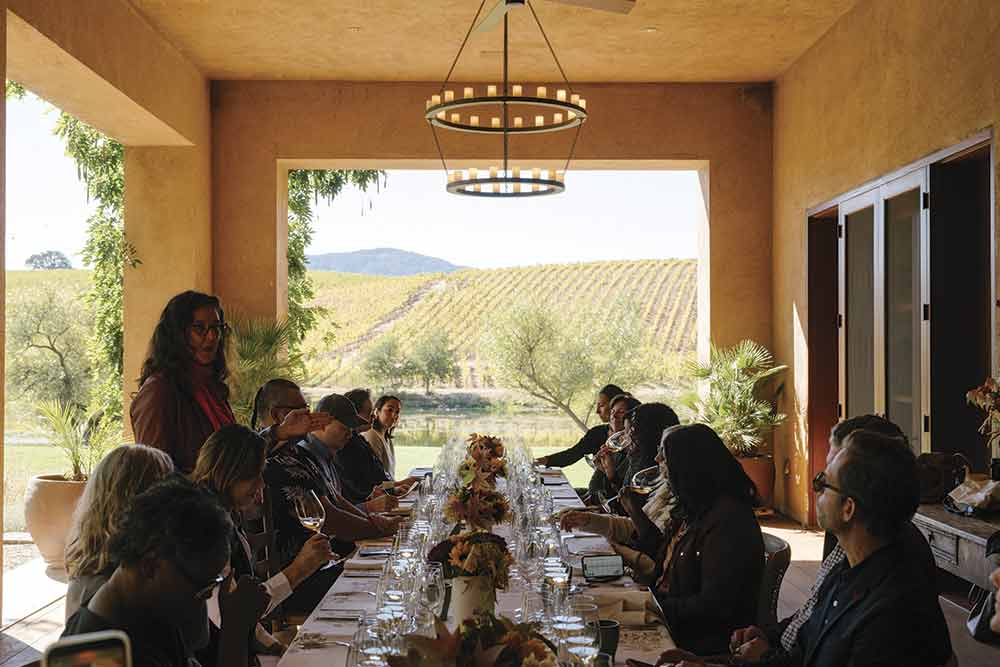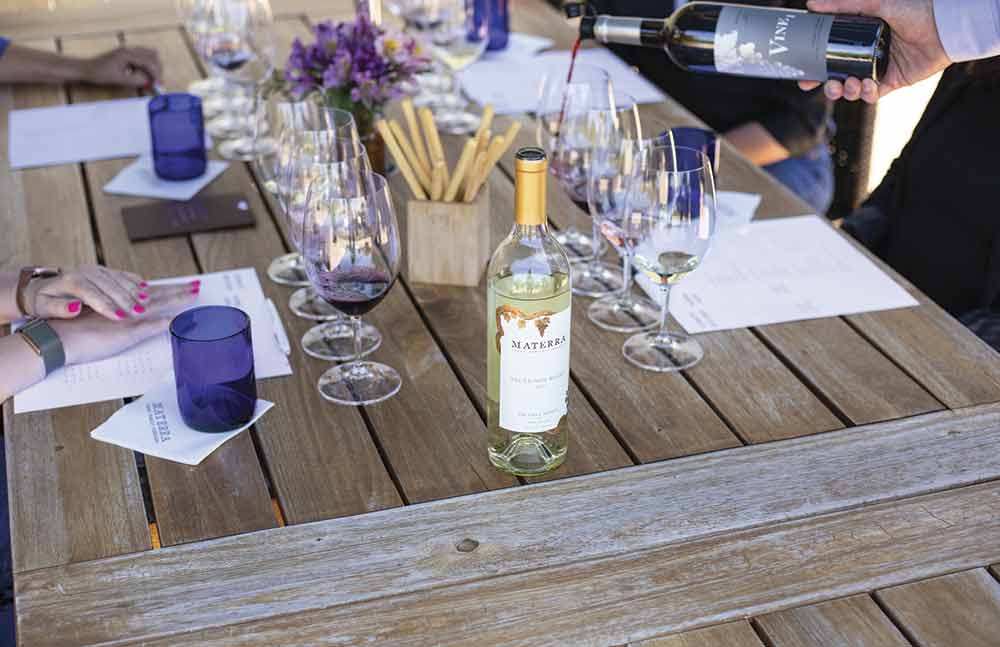SIP Feature
White Wine is Winning
Why Consumer Interest in White Wine is Increasing in Napa Valley
WRITTEN BY Layne Randolph
|
Published On: April 30, 2025

Rebekah Wineburg of Quintessa and Molly Sheppard of Spottswoode // Photo by Mike Battey
For decades, white wine has been overshadowed by its red friends, especially in Napa Valley, renowned for its excellence in Cabernet Sauvignon production; in this valley, “Cab is King.” This has been partly because white wine was viewed as less serious, merely an introduction to wine tastings or a fun wine to enjoy at casual events. Yet, the industry trend is toward lighter wines, especially white wine.
According to Nielson IQ (via winebusiness.com), from July 2023 to July 2024, total red wine sales dropped 6.6 percent, while white wine decreased by just 1.2, an indicator of white’s increasing hold on the consumer.
Colleen Fitzgerald, Head Winemaker at Napa Valley’s Pine Ridge Vineyards, explained Pine Ridge’s experience. “The refreshing white category has been [growing] on the inherent nature of being bright, fruity, and easy to pair with food. Consumers increasingly seek wines that can be both sophisticated and relaxing, perfect for unwinding after a busy day.”
Chelsea Barrett, Winemaker at Materra Cunat Family Vineyards, shared, “A rise in popularity for white wines may be because they’re more approachable for a younger consumer as an introduction to wine, both in terms of appreciation and affordability.”
The Driving Forces
Undeniably, part of the shift comes down to health and cost. White wine is less expensive than red, especially at the premium level, and in an uncertain economy, even wine lovers prefer some savings. It’s well known that consumers are more mindful than ever about their health, resulting in a preference for lighter wines with lower alcohol content and calories. Also, white wine is a natural pairing for lighter, healthier cuisine.
White wine is versatile. It has long been regarded as an excellent pairing with seafood, poultry, fresh salads, and soft cheeses, while red wine is often paired with hearty, rich foods like steaks and roasted meats. Whether it’s a crisp Sauvignon Blanc with a fresh salad or a refreshing Chardonnay alongside grilled seafood, options for pairing white wine with lighter dishes are virtually endless. As consumers have become more adventurous in their food choices, they have also discovered that white wine can enhance and complement a wide range of ethnic dishes, both delicate and spicy.
The global trend of alcohol moderation is another driving force behind the rise in white wine’s popularity. The lower-alcohol movement, which encourages consumers to moderate their alcohol intake, has gained significant traction in recent years. This movement has influenced the growing preference for wines with lower alcohol levels, and many drinkers are now opting for white wines, which typically have an alcohol by volume (ABV) ranging from 11 to 13 percent, lower than many red wines, which can often exceed 14 percent ABV.
To meet the moment, some wineries are experimenting with creating lighter, lower-alcohol wines via dealcoholizing and other methods. While there is a rise in low-ABV reds, white wines have historically and naturally lent themselves to the lower alcohol preference, with lighter options available across multiple styles, including sparkling wines.

Colleen Fitzgerald, Head Winemaker of Pine Ridge Vineyards, holding the Chenin Blanc + Viognier // Photo courtesy of Pine Ridge.
Discovering New Varieties
There is a more optimistic outlook on white wine’s appeal. Consumers may simply want to discover new varieties and ways to enjoy wine. It’s another reason “white wine is winning” in today’s wine market.
In Napa Valley, most wineries produce classic whites like Chardonnay and Sauvignon Blanc, even if the wineries focus on reds. However, the modern wine market is more diverse than ever, and consumers have increased access to international and domestic white wines, leading to a broader appreciation for white wines and a growing demand for more.
At Materra, Barrett makes Viognier, Albarino, Sauvignon Blanc, and two Chardonnays. “I’m happy to see white wines gaining in popularity. I really enjoy making a range of different whites for Materra. We have five, and that’s pretty uncommon for Napa. They all have very expressive and unique aromatics, and I like figuring out interesting food pairings.”
Adam Casto, head winemaker at Ehlers Estate and producer of 2023 Sylviane Estate Blanc, shared his insights. “Who would have predicted 20 years ago that the role of red wines as the primary focus of attention and dollars would soon be challenged by crisp, complex, and fresh whites? For my own interests as a wine consumer, I could not be more pleased to see such a diversity of offerings from all around the world to supply this demand, and as a winegrower, I could not be more pleased to supply it.”
In addition to well-known white wine regions producing quality whites, there has been an increased focus on indigenous grape varieties worldwide, uncovering a multitude of whites that were overlooked or unknown by wine lovers outside their borders. Wines like Vermentino from Italy, Albariño from Spain, and Assyrtiko from Greece, previously considered niche wines, have gained a devoted international following.
Unsurprisingly, Napa Valley winemakers are now growing some of these lesser-known varietals in California soil. For example, Bouchaine Vineyards released its inaugural Alsatian blend incorporating Pinot Gris, Pinot Blanc, Riesling, and Gewurztraminer. Massican Wines produces Falanghina, Ribolla Gialla, and Tocai Friulano. Exposure to these varieties, not commonly found in California, has also helped spark interest in white wines.
Winemaking Innovations
Another positive factor contributing to the rise in white wine consumption is the increasing awareness of its potential quality and diversity. For many years, serious connoisseurs overlooked white wine in favor of red, with some consumers associating it with sweeter, lower-quality options. However, over the past decade, the wine world has transformed, and consumers of all types are now discovering that white wine can be just as complex, nuanced, and age-worthy as red.
Elaine Chukan Brown, renowned wine writer, educator, and author of The Wines of California, explained the short history of white wine in Napa Valley. “White wine used to be like Sprite. If you talk to people from the mid-twentieth century, they’ll tell you it was a sweeter, limey wine. Then, in 1966, Robert Mondavi made a dry, barrel-fermented white wine (Sauvignon Blanc) and called it Fumé Blanc to set it apart. But well into the eighties, there were still very few [wineries] working with Sauvignon Blanc.”
One of the few wineries making a name for Sauvignon Blanc at that time was Spottswoode Winery. It began producing elevated Sauvignon Blanc in the 1980s using advanced winemaking techniques, such as blending portioned wines fermented in separate vessels. Spottswoode uses ceramic, clay amphora, stainless steel, and concrete combinations.
For Quintessa’s 2022 Illumination Sauvignon Blanc, wines were fermented in concrete eggs, French oak, acacia, and stainless steel. Expertly blended nuanced flavors from each vessel combine to create a Sauvignon Blanc with a complexity and texture that distinguishes it from the standard.
Constructed with this skill level, white wines have an incredible aging potential, even white wines like Sauvignon Blanc that aren’t known for it. Of course, not all whites are amenable to aging. Molly Sheppard of Spottswoode shared, “It has to be an intentional and purposeful choice to age a white wine.”
Brown has a positive outlook on white wines’ newfound popularity and compared it to an industry shift a few decades ago. “There was a clarity of vision by the end of the nineties when everyone said, Oh, that’s what does well here [Cabernet Sauvignon].’ We’re now coming into another opportunity. [Some of] Napa may be forced to replant due to red blotch.” Perhaps this is the time to make another industry shift. “Right now is an exciting time because anytime there’s a change or crisis point, there’s actually an opportunity.”
Looking to the future, it’s clear that drinking white wine is not just a passing trend. The rise in health-conscious trends, the versatility of white wine in food pairings, and the growing awareness of its quality, multitude of diverse varieties, and aging potential are just a few of the key reasons consumers choose white wine more than ever. As the market continues to evolve, offering even more exciting and dynamic options for wine lovers to explore, the future of white wine is bright, and it’s winning in the hearts and glasses of wine drinkers worldwide.

Elaine Chukan Brown speaking at The Art of Age-Worthy White Wines masterclass event at Quintessa // Photo by Mike Battey
White Wines Worth Noting
2023 Spottswoode Sauvignon Blanc | 94 points, Wine Spectator
This wine is expressive and exuberant, with peach, white florals, and orange peel that unfold immediately. Its sense of yellow pear flavors on the mid-palate leads to a long finish.
2022 Quintessa Illumination Sauvignon Blanc
Fresh, vibrant and floral with succulent citrus notes, this wine has a fresh and lively mouthfeel that offers energetic acidity with even ripeness.
Pine Ridge Chenin Blanc and Viognier | 91 Points, James Suckling
Crisp, bright, and vivacious, the Chenin aromatics bring citrus characters of tangerine, yuzu, pear, orange blossom, and honeydew melon. The Viognier aromatics add stone fruit of peach and mango with hints of honeysuckle.
2023 Ehlers Estate Sylviane Estate Blanc
This wine is delicate but serious, with citrus blossoms, green tea, and fresh oysters on the nose. It has a soft mouthfeel, which gains momentum with a mineral-inflected acidity.
Bouchaine Alsatian Blend | 92 points, James Suckling
This wine is lightly floral and fruity with full body. Citrus blossoms, lime zest, crisp green apples, and a hint of honey give this dry wine nice complexity.
2023 Materra Cunat Yamabuki Albarino
Full of vibrant aromatics, this wine is fruit-forward with notes of pineapple and citrus with a hint of rose. It has excellent minerality and crisp acidity.


